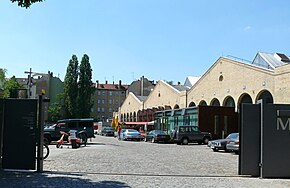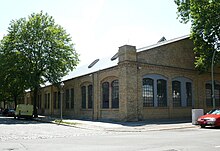Moabit depot
The Moabit depot is a former tram station of the Berlin tram . It was put into operation in 1901 as station XII of the Great Berlin Tram (GBS) and closed in 1964 by the Berliner Verkehrsbetriebe . The so-called Wiebehallen then served as storage rooms for the BVG and BEHALA . In 2002 the state of Berlin sold the halls to a private group of investors. In 2003, the Meilenwerk Berlin was opened in the halls and has been operating under the name Classic Remise Berlin since 2010 .
Location and structure
The former depot area includes the addresses Wiebestrasse 29-39 and Sickingenstrasse 59-61 in the Berlin district of Moabit . It has an area of around 20,400 square meters, of which the wagon hall in the north takes up around 12,200 square meters. In the southern part, the former track apron, there is a daycare center with a playground and a three-story residential building. At that time, the house also served as the management of the farm. It is kept in the historicizing brick style and thus represents the opening state.
The carriage hall has four aisles with six basket arch gates each. Four skylight caterpillars are used for lighting , which stretch over the entire length of the hall and are supported by iron trusses. The design goes back to the technical director of the GBS Joseph Fischer-Dick . The facade originally had Gothic decor such as battlements and arched friezes . In 1926 the hall was rebuilt according to plans by Jean Krämer and its design was simplified considerably. In addition to the removed decoration, the angled gables were reduced to simple triangular areas, the oculi were retained.
In the most recent redesign in 2002/03, the halls were refurbished in accordance with listed buildings and new fixtures were added that stand out from the previous structure. The four halls have been redistributed in terms of use. Workshops are located in the east aisle of the hall, while in the west there are the partly two-story storage boxes and areas for automobile and motorcycle dealers as well as various service rooms. In the two central halls there are additional storage boxes, the event and catering area, service rooms and shops for visitors.
The entire system consisting of the halls and auxiliary buildings as well as the former administration building is a listed building . On the occasion of the renovation, it was also awarded the Ferdinand von Quast Medal of the State of Berlin in 2004.
history
The depot was built on the occasion of the electrification of the GBS network together with seven other yards at the turn of the century. After two years of construction, the farm was opened on March 1, 1901. With a capacity of 325 cars on 24 hall tracks, it was the largest tram station in Europe when it went into operation. At times, over a thousand employees were on duty on the farm, which was home to up to ten lines. The main lines of the 1920s and 1930s also include the ring lines 3 (Großer Ring), 4 (Ost-West-Ring) and 8 (Nordring). The latter continue to drive under a different number and on a shortened route. Around 1935 the farm received the internal abbreviation Moa .
On August 1, 1964, the BVG closed the depot. It then served initially as a railway maintenance office and as a storage area for the TF 50 railcars that were no longer required and were also scrapped here. Part of the halls was used by BEHALA as storage space. In the early 1990s, various artists initially used the halls before they had to be closed in 1996 due to construction defects.
In 2002 a GbR made up of three private investors acquired the halls from the state of Berlin. These were then refurbished in accordance with listed buildings and redesigned according to plans by the Hamburg architects Dinse, Feest and Zurl . In 2003 the Meilenwerk , a service center for classic cars , was opened in them. Since then, workshops and service facilities for the vehicles have been located in the halls, as well as dealers and vehicle clubs. Private individuals can present their vehicles to visitors in 88 glass parking boxes. In addition, there is an event and catering area for various events. According to the owner, around 200 events of various kinds take place every year. In 2010, the operators of the locations in Berlin and Düsseldorf renamed Classic Remise .
literature
- Bernd Hettlage: Meilenwerk Berlin . In: The New Architecture Guide . tape 124 . Stadtwandel Verlag, ISBN 978-3-86711-047-1 .
- Siegfried Münzinger: The depots “Schön” and “Moa” . In: Berliner Verkehrsblätter . Issue 11, 1964.
Web links
Individual evidence
- ↑ a b c Entry in the Berlin State Monument List with further information
- ^ Awarded the Ferdinand von Quast Medal. In: Berlin.de. Senate Department for Urban Development, December 15, 2004, accessed March 15, 2013 .
- ^ A b Siegfried Münzinger: The depots "Schön" and "Moa" . In: Berliner Verkehrsblätter . Issue 11, 1964, pp. 141 .
- ↑ The use of cars on the Berlin tram lines in 1928 and 1937 . In: Berliner Verkehrsblätter . Issue 12, 1972, p. 168-169 .
- ^ Siegfried Münzinger: Tram profile. Episode 24 . In: Berliner Verkehrsblätter . Volume 5, 1977, pp. 100 .
- ↑ On the way to Moabit, the city of the workers . In: Berliner Zeitung . February 22, 2006.
- ↑ Events and tours. In: Classic Remise Berlin. Retrieved March 15, 2013 .
- ↑ Classic Remise Berlin. In: Classic Remise Berlin. Retrieved March 15, 2013 .
- ↑ Information on the former Meilenwerk locations in Berlin & Düsseldorf. (No longer available online.) In: Meilenwerk. Forum for driving culture. Archived from the original on September 8, 2012 ; Retrieved March 20, 2013 . Info: The archive link was inserted automatically and has not yet been checked. Please check the original and archive link according to the instructions and then remove this notice.
Coordinates: 52 ° 31 ′ 50 ″ N , 13 ° 19 ′ 7 ″ E


